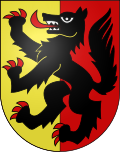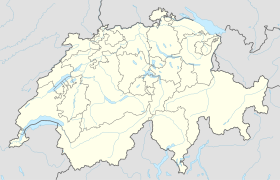Vauffelin
| Vauffelin | ||
|---|---|---|
| State : |
|
|
| Canton : |
|
|
| Administrative district : | Bernese Jura | |
| Residential municipality : | Suck | |
| Postal code : | 2537 Vauffelin 2535 Frinvilier |
|
| former BFS no. : | 0447 | |
| UN / LOCODE : | CH VFN | |
| Coordinates : | 589 494 / 226 262 | |
| Height : | 707 m above sea level M. | |
| Area : | 5.92 km² | |
| Residents: | 455 (December 31, 2013) | |
| Population density : | 77 inhabitants per km² | |
| Website: | www.vauffelin.ch | |
| map | ||
|
|
||
Until December 31, 2013, Vauffelin was a political municipality in the Bernese Jura administrative district in the canton of Bern in Switzerland . The former German names Füglisthal or Wölflingen are no longer used today. On January 1, 2014, Vauffelin merged with the former municipality of Plagne to form the new municipality of Sauge .
geography
Vauffelin lies at 707 m above sea level. M. , seven kilometers northeast of Biel (linear distance ). The former farming village extends in a dry valley , a syncline , north of the Jura chain of the Bözingenberg.
The area of the 5.9 km² former municipal area includes the dry valley of Vauffelin in a long narrow strip, which slopes to the west to the valley of the Schüss ( French: Suze ). In the far west, the area near Frinvillier extends to the Schüss, which forms a valley here between the two breakthrough valleys, the Klus von Rondchâtel in the north and the Taubenloch Gorge in the south. The municipality extends to the south on the ridge of the Bözingenberg (up to 974 m above sea level ). In the north, Vauffelin reaches the anticline of the Montagne de Romont , on which at 1100 m above sea level. M. the highest point of the municipality is reached. On this ridge there are extensive Jura high pastures with the typical mighty spruce trees , which either stand individually or in groups, as well as a few weekend and holiday homes scattered around. In 1997, 8% of the municipal area was in settlements, 56% in forests and woodlands, 35% in agriculture and a little less than 1% was unproductive land.
The village of Frinvillier ( 532 m above sea level ) to the left of the Schüss and a few individual farms belong to Vauffelin . Until December 31, 2013 Vauffelin were neighboring communities: Orvin , Péry , Plagne , Romont , Pieterlen and Biel.
population
With 455 inhabitants (as of December 31, 2013) Vauffelin is one of the smaller communities in the Bernese Jura . 64.9% of the residents are French-speaking, 24.7% German-speaking and 7.4% speak Albanian (as of 2000). The population of Vauffelin was 255 in 1850 and 258 in 1900.
politics
The voting shares of the parties on the occasion of the National Council elections in 2011 were: SVP 27.6%, SP 22.7%, GPS 15.9%, FDP 9.0%, BDP 6.0%, EDU 5.8%, Les Rauraques 4, 7%, SLB 2.4%, glp 1.7%, AL 1.5%, PdA 1.1%, EVP 0.4%, CVP 0.1%.
economy
Vauffelin is still today characterized by agriculture , with cattle breeding and dairy farming predominating, in the vicinity of the village there are also arable crops and fruit trees . Local small businesses offer additional jobs. In the last few decades Vauffelin has developed into a residential community; A new residential quarter was built on the slope above the old town center. Many employed people are commuters and work in the city of Biel or in the Grenchen region .
traffic
The village of Vauffelin is located off the major thoroughfares on the cantonal road from Frinvillier to Grenchen. Vauffelin is connected to the public transport network through the Postbus course, which runs from Biel to Romont.
Frinvilier, on the other hand, which is largely located in the former municipality of Vauffelin, is well developed with a connection to the A16 motorway and a station on the Biel / Bienne – La Chaux-de-Fonds railway line.
Further training
There are various branches of the automotive engineering department of the Bern University of Applied Sciences for Technology and Information Technology , which has its headquarters in Biel . The laboratory for electrical engineering, the laboratory for mechatronics, the laboratory for vehicle mechanics and the so-called Dynamic Test Center are located in Vauffelin. The last-mentioned test site is located near the headquarters of the automotive technology department in Biel and has been supported by both the private sector and the above-mentioned technical college since it was founded in 1994.
history
Early medieval iron industry
Striking terrain forms can be observed south of the village of Vauffelin (corridors Ecovots and Fousserets). These movements of material can be traced back to excavations for Bohnerz by the Moutier-Grandval monastery in the early Middle Ages. At the time of the Merovingian kings and Christianization, the area was owned by this monastery, founded in 636. The Vauffelin Church stands in the middle of the former mining zone on the site of a chapel, which served as a place of prayer for the monks as early as the 7th century.
The artisanal iron production was labor-intensive: the prospecting, cleaning the ore, extensive logging for charcoal production and the corresponding transports required numerous auxiliary workers. During the migration period, the leading monastery staff was able to rely on the Alemanni , who probably brought with them knowledge of iron production from southern Germany.
It is uncertain whether the ore from the pits around the church of Vauffelin was smelted into iron on the spot. On the occasion of renovation work in 1983, a clay structure was discovered under the church floor, which can be interpreted as the remains of a wolf oven. No other evidence of smelting in the form of slag heaps is known to this day. The Vauffelin valley is karst and has no running water. It is possible that the cleaned ore was transported over to the Birstal, where there were more favorable conditions for smelting with hydropower. During the church renovation in 1983, a woman's grave was found in addition to the clay structure mentioned, which the Archaeological Service of the Canton of Bern also assigned to the Merovingian period based on its location and typical design. This grave has been robbed. The skeleton is well preserved, but the skull has been misplaced and some bones stolen. A reference to the early medieval iron trade is obvious. The woman buried here must have performed an important function.
Derivation of the place name
The immigrant Alemanni named the area of the ore mines Wolflingen, alluding to the simple shaft furnaces for making iron dolls . This facility for smelting was called the Wolf furnace or also the racing furnace. The German name Wolflingen was later changed by patois speakers to the similarly sounding Wolflin, later to Vauffelin. The Swiss Ortnamenslexikon derives the name Vauffelin from "Vallée de Fukolin", and the German names Füglisthal and Wölflingen are different later Germanizations.
Later iron craft in the area
The ore mines northwest of Vauffelin below the neighboring village of Plagne (field name Cotattes) show a less advanced state of weathering. They were later exploited, probably at the end of the 17th century, when the Reuchenette blast furnace had to be supplied. At the same time, the Creux des Mines (behind Péry) and the pits behind the Schlössliheim in Pieterlen were in operation. Bohner ore was definitely smelted in Plagne, the field name Les Ferrières reminds of it. From the early to the high Middle Ages, the production and utilization of the strategic raw material iron from the Jura behind Biel was in the hands of the Moutier-Grandval monastery. In the late Middle Ages it was the Basel prince-bishops who controlled iron production on their territory. They granted the right to exploit iron as a fiefdom to the local aristocracy, from which various Biel patrician families could also benefit. The local clay ore deposits were exhausted at the beginning of the 18th century. Jura iron, which was obtained from the episcopal ironworks in Undervelier and Courrendlin, continued to be processed in the hammer forges and wire drawing companies in Reuchenette, Frinvillier and Bözingen.
The first written mention of Vauffelin under the name Walfelim took place in 1188; the first German name was Fögenlinsthal ( valley of the birds ). Until 1797 the village belonged to the Erguel lordship , which was subordinate to the Duchy of Basel , whereby the city of Biel also exerted greater influence at times and introduced the Reformation in 1530 . From 1797 to 1815 Vauffelin belonged to France and was initially part of the Mont-Terrible department , which was connected to the Haut-Rhin department in 1800 . As a result of the decision of the Congress of Vienna , the place came to the canton of Bern in the Courtelary district in 1815 .
Until December 31, 2013, Vauffelin was an independent municipality .
Attractions
A little outside the village is the Reformed Church, built between 1715 and 1716 with the inclusion of the walls of a medieval chapel. It was rebuilt in 1900 and provided with an octagonal bell tower with an onion dome. Some old farmhouses from the 17th and 18th centuries have been preserved in the town center.
Above Frinvillier, at the entrance to the Rondchâtel gorge, traces of a Roman road are visible at Martinsklafter .
literature
- Hans Rickenbacher: Die Eisenmacher from Bieler Jura - Les fabricants du Jura Biennois , Vauffelin 2014, ISBN 978-2-8399-1413-0
Web links
- Official website of the municipality of Vauffelin (French)
- Christine Gagnebin-Deacon: Vauffelin. In: Historical Lexicon of Switzerland .







